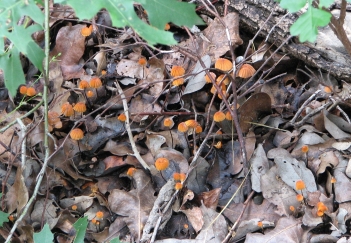Mushroom; Tissue Mushroom Coprinus sp; These little white mushrooms have a slender stalk up to 3” tall, with a tissue thin cap that is pleated on top, and lined with delicate gills radiating out from the stalk on the underside. The stalk does not have a ring, or visible volva. The mushroom body is the visible portion of fungus, which otherwise in a network of filaments working their way through dead material on the forest floor. When the mycorrhiza (tiny roots) of two different fungi of the same species meet, they produce fruiting bodies, like these mushrooms, often in clusters, or linear groups, which releases spores. The cap begins as a bullet shaped tip, which opens to a flat surface, then the cap curvs upward at the outer rim, helping to release the spores. These mushrooms help break down the leaf litter, often connecting directly to the root hairs of trees, supplying them with nutrients as they break down leaf litter and dead wood. Since fungi do not contain chlorophyll, they usually lack color pigments, appearing white, or sometimes brown/tan, the spores often being black. Fungi need water, so many mushrooms appear only in seasons when there is ample rainfall, the spores laying dormant until conditions are right.

Tissue Mushroom habit; small, white mushrooms lacking a basal volva, consisting of thin stalks with no ring, with tissue thin, pleated caps that have radial gills on the undersurface

Note; tissue mushrooms often grow in clusters or lines, sprouting where the mycorrhiza of two separate fungi meet

Note; tissue thin cap pleated on the upper surface, with delicate gills on the lower surface






















